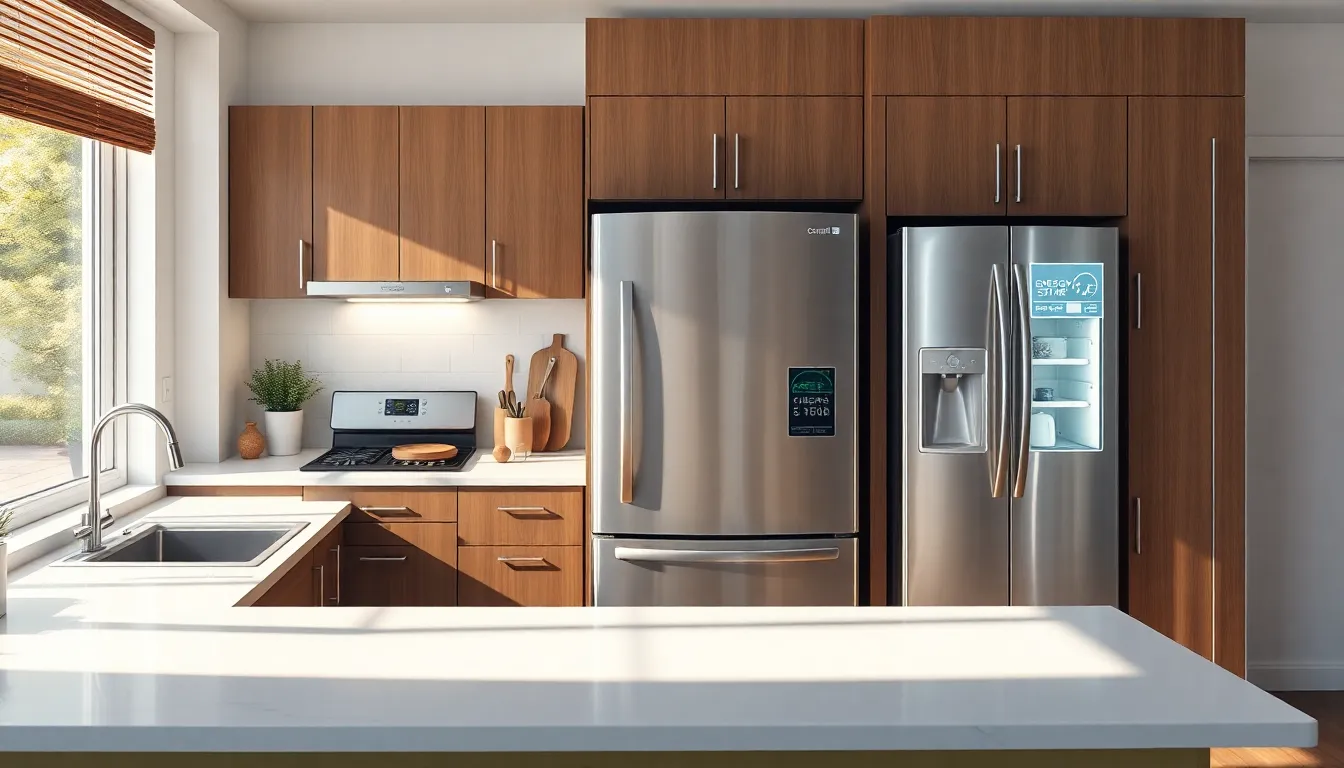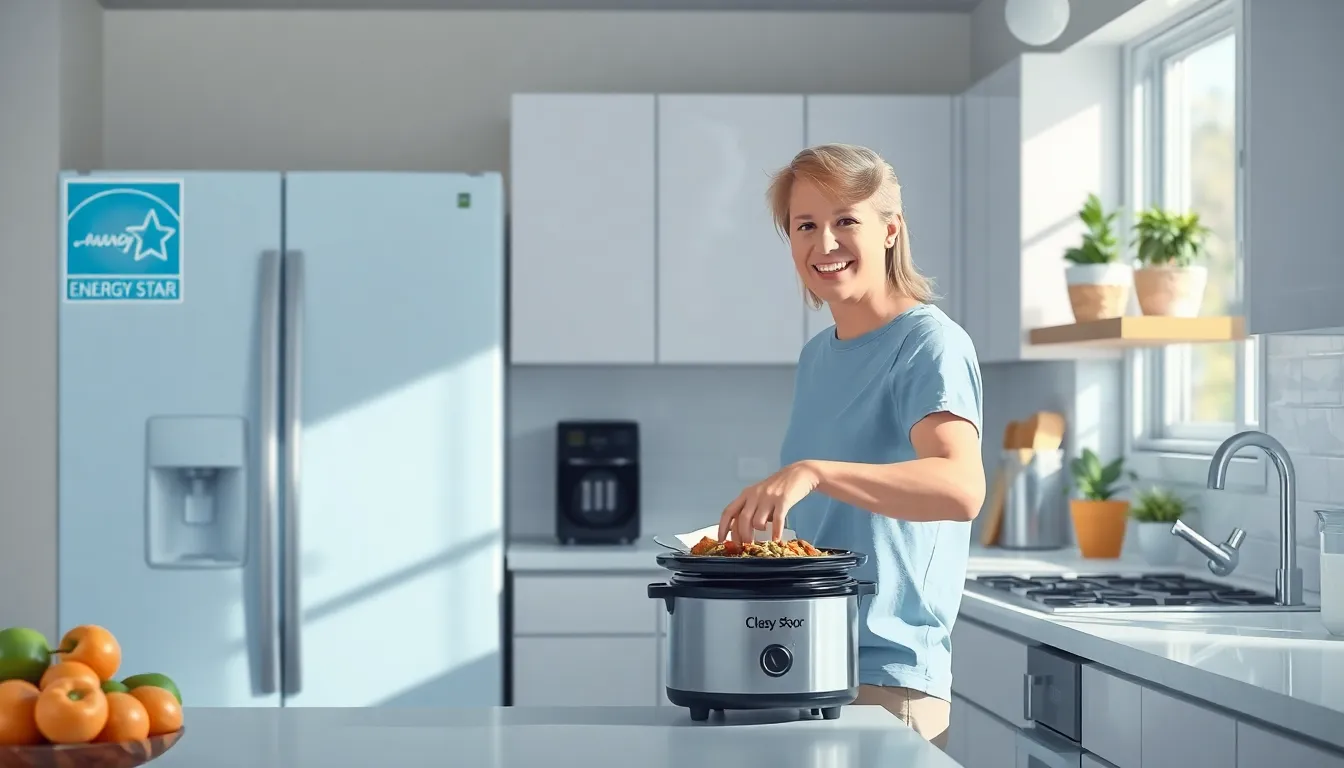In a world where energy bills can rival a small country’s GDP, finding ways to save energy in the kitchen is like discovering a hidden treasure. Who wouldn’t want to whip up a delicious meal while also being a superhero for the planet? With a few simple tweaks, anyone can turn their kitchen into an eco-friendly haven that saves energy and cash.
Table of Contents
ToggleUnderstanding Energy Efficiency in the Kitchen
Energy efficiency in the kitchen plays a crucial role in reducing energy consumption. Simple changes can lead to significant savings on monthly energy bills.
Importance of Energy Efficiency
Energy efficiency represents a commitment to reducing energy waste. A focus on this aspect helps lower overall energy costs while minimizing environmental impact. Saving energy in the kitchen reduces reliance on non-renewable resources. Implementing energy-efficient practices contributes to a sustainable lifestyle. Higher demand for energy-efficient appliances fuels market innovation, promoting advancements in technology.
Benefits of an Energy-Efficient Kitchen
An energy-efficient kitchen results in various advantages. First, significant cost savings occur due to lower utility bills. Second, enhancing home comfort and convenience makes cooking more enjoyable. Third, improving indoor air quality arises from better ventilation and reduced pollutants. Access to energy-efficient appliances leads to increased cooking efficiency and quicker meal prep. Moreover, adopting sustainable practices inspires family members to engage in eco-friendly habits, fostering a culture of conservation at home.
Energy-Efficient Appliances

Choosing appliances that prioritize energy efficiency greatly impacts energy consumption. Selecting appliances with Energy Star ratings ensures significant energy savings. These products meet strict efficiency guidelines set by the U.S. Environmental Protection Agency. An Energy Star-rated refrigerator, for example, can use 15% less energy than standard models. Investing in these appliances represents a commitment to reducing monthly utility costs.
Using appliances efficiently also contributes to overall energy savings. Setting dishwashers to eco mode can reduce water and energy usage significantly. Regularly cleaning the lint trap in dryers enhances efficiency and drying time. Cooking meals in larger batches saves energy, as preheating becomes unnecessary when using the oven for multiple dishes. Utilizing slow cookers or microwaves for smaller meals can further cut energy consumption. Additionally, turning off appliances instead of leaving them on standby minimizes energy waste.
Smart Cooking Techniques
Smart cooking techniques make meal preparation efficient while conserving energy. Small changes in approach lead to cost savings and reduced environmental impact.
Meal Planning and Prep
Meal planning cuts down on food waste and saves time cooking. Organizing meals for the week streamlines grocery shopping. He or she can use a shopping list with only needed ingredients. Preparing ingredients in advance saves energy when cooking. Cooking larger portions also eliminates the need for multiple cooking sessions in one week. Batch cooking creates leftovers, reducing energy consumption from reheating later.
Utilizing Cooking Methods Wisely
Utilizing different cooking methods enhances energy efficiency. Slow cookers and pressure cookers require less energy than traditional ovens. Microwaves cook food faster and consume less power. Grilling outdoors reduces heat buildup in the kitchen and uses less energy than indoor alternatives. Using lid-covered pots accelerates cooking times for boiling or simmering. Additionally, placing food items near the heat source maximizes energy efficiency.
Home Improvements for Energy Efficiency
Improving a kitchen’s energy efficiency significantly lowers energy costs. Several home improvements, such as insulation and lighting upgrades, play a vital role in achieving this goal.
Insulation and Sealing
Effective insulation and sealing prevent heat loss, enhancing a kitchen’s energy efficiency. Properly insulated walls and ceilings maintain a consistent temperature, reducing the need for heating and cooling. Sealing gaps around windows and doors prevents drafts, ensuring that conditioned air remains inside. For instance, using weather stripping can drastically improve comfort levels. Additionally, an insulated water heater helps maintain water temperature while using less energy. Regular inspections identify areas needing more insulation, providing opportunities to boost efficiency and comfort year-round.
Upgrading Lighting Options
Efficient lighting transforms a kitchen’s atmosphere while conserving energy. Switching to LED bulbs stands out as one of the most effective upgrades. These bulbs consume up to 75% less energy than traditional incandescent bulbs and last significantly longer. Installing dimmer switches allows users to control light levels, resulting in further energy savings. Task lighting directs illumination where it’s needed, reducing the reliance on overhead fixtures. Incorporating natural light enhances brightness while lowering energy use during daylight hours. Overall, optimizing lighting options creates an inviting atmosphere and supports energy efficiency.
Sustainable Practices
Sustainable practices in the kitchen significantly reduce environmental impact while conserving resources. Implementing these methods creates a more eco-friendly cooking environment.
Reducing Water Waste
Reducing water waste remains crucial for sustainability. Using a dishwasher instead of hand washing can save up to 5,000 gallons of water annually. Fixing leaky faucets prevents unnecessary water loss, saving more than 3,000 gallons per year for each drip. Collecting leftover cooking water provides a way to irrigate plants. Installing low-flow faucets and showerheads in the kitchen further minimizes water usage and conserves energy. Regularly checking for leaks and running dishwashers only with full loads enhances efficiency and conserves water.
Composting and Recycling
Composting and recycling contribute to minimizing kitchen waste. Compost bins can reduce food waste by 30%, which benefits gardens. Setting up separate bins for recyclables encourages proper disposal of items like cardboard and glass jars, thus minimizing landfill overflow. Investing in a countertop compost collector simplifies sorting organic waste. Educating the family about what can and cannot be recycled promotes a culture of sustainability. Regularly emptying compost bins keeps the kitchen clean and odor-free while supporting healthy soil.
Implementing energy-efficient practices in the kitchen can lead to substantial savings and a more sustainable lifestyle. By making small adjustments and embracing smarter cooking techniques, individuals can significantly reduce their energy consumption.
The choice of energy-efficient appliances and thoughtful meal planning not only cuts costs but also promotes a healthier home environment. Simple actions like sealing gaps to prevent drafts or switching to LED lighting can further enhance energy efficiency.
Encouraging family members to adopt these eco-friendly habits fosters a culture of conservation that benefits both the household and the planet. With these tips, anyone can create a kitchen that’s not just functional but also environmentally responsible.



